Exploring the Significance of Orange and Black Crystals


Intro
The realm of orange and black crystals presents a unique intersection of natural science, culture, and human fascination. As we delve into the properties and significance of these minerals, we uncover rich histories and the roles they have played in various civilizations. From geological formations to their applications in modern life, understanding these crystals offers insights into our planet's evolution and the cultural narratives that accompany them.
History and Origins
Overview of Collectibles, Rocks, and Fossils
Collecting crystals, rocks, and fossils is more than just a hobby; it is a journey through time. Orange and black crystals, in particular, exhibit geological diversity. These gemstones often carry tales of their origin. Some form from volcanic activity, while others crystallize from sedimentary processes. Notable examples include Carnelian, a vibrant orange crystal known for its historical use in jewelry, and Obsidian, a naturally occurring volcanic glass that appears deep black.
Historical Significance and Cultural Impact
Throughout history, these crystals have left significant marks on cultures around the world. The Ancient Egyptians valued Carnelian for its alluring color, using it in jewelry and burial ornaments. Similarly, Obsidian held importance in Mesoamerican cultures for tool-making and ceremonial objects. This historical utilization speaks volumes about human interaction with these natural materials, highlighting the blend of artistry and functionality.
"The beauty of these crystals transcends mere aesthetics; they embody ancient stories and human ingenuity."
Identification and Classification
Guide to Identifying Rocks and Fossils
For enthusiasts and collectors alike, accurate identification of orange and black crystals is essential. Key characteristics include:
- Color: Observe the hue. Carnelian can range from orange to red, while Obsidian remains harshly black.
- Luster: Examine how light reflects off the crystal. Carnelian often displays a glassy shine, while Obsidian has a smooth, mirror-like finish.
- Hardness: Utilizing the Mohs scale can assist in determining the crystal's hardness, with Obsidian scoring around 5 to 5.5 and Carnelian at 7.
Common Types and Variations
There are various types of orange and black crystals, each with unique traits:
- Carnelian: Known for its warm orange tones, often used in beads and carvings.
- Obsidian: Characterized by its glassy texture and deep black color, versatile for tools and ornaments.
- Tiger's Eye: Exhibits golden to reddish-brown tones with bands that can be mistaken for black.
Understanding these unique identifiers is critical for collectors seeking authenticity in their collections. As enthusiasts sift through potential finds, recognizing these traits will enhance their appreciation and knowledge of the diverse world of crystals.
Prolusion to Orange and Black Crystals
Orange and black crystals stand out in the diverse world of minerals. Their unique hues not only catch the eye but also tell a story of geological processes and cultural significance. This section serves as a gateway to understanding what makes these crystals notable, exploring their definitions, the interplay of color in crystal formation, and highlighting examples that collectors and enthusiasts find intriguing.
Defining Crystals
Crystals are solid materials where atoms are arranged in an ordered pattern. This symmetry leads to distinct shapes and forms, which vary significantly among the different types. Understanding the structure of crystals is essential for recognition and classification. When we refer to orange and black crystals, we imply minerals that showcase these colors through various processes in nature. Knowledge of crystal definitions sets the foundation for diving deeper into their geological origins and applications.
Overview of Color in Crystals
Color in crystals is the result of various factors such as composition, light interaction, and impurities. The presence of specific mineral elements influences the coloration. For instance, elements like iron can impart an orange hue, while minerals with manganese might appear black. These connections between elemental composition and color ultimately affect how collectors value and use these crystals. The study of color can also reveal insights into geological conditions during formation.
Common Examples of Orange and Black Crystals
Several crystals exemplify the captivating colors of orange and black. Some of the most recognized include:
- Carnelian: A form of chalcedony, carnelian exhibits vibrant shades of orange and is often used in jewelry.
- Hematite: Known for its metallic black shine, hematite often forms in sedimentary environments.
- Obsidian: A volcanic glass that can appear black, obsidian sometimes exhibits orange hues when found with other minerals.
These examples not only display the aesthetic appeal of orange and black crystals but also reflect their diverse uses, ranging from art to healing practices. Understanding these common examples enhances appreciation for their roles in both nature and human culture.
"The beauty of crystals is not just in their appearance, but in their ability to connect us to Earth's history and processes."
This introduction sets the stage for exploring the deeper geological aspects, unique identification techniques, and the multitude of uses for these fascinating natural specimens.
Geological Formation of Crystals
Understanding the geological formation of crystals is crucial to appreciate the intricate processes behind orange and black crystals. These crystals are not mere components of Earth's surface; they tell a detailed story of both environmental conditions and geological history. The processes that lead to their formation provide insights into the conditions present at the time of their genesis, which helps collectors and enthusiasts to contextualize their finds.
Mineral Formation Processes
Mineral formation involves various processes including crystallization from magma, cooling of lava, evaporation of water, and even biological activities. Each method is significant in forming distinct types of crystals. For example, when magma cools slowly beneath the earth's surface, minerals can crystallize out of the molten rock, forming large, well-defined crystals. This process is known as igneous crystallization.
Conversely, orange and black crystals can form through metamorphism. This has to do with existing minerals being subjected to high pressure and temperature over long periods, altering their structure and producing new crystal forms. Sedimentary processes contribute as well; through evaporation, minerals like halite and gypsum precipitate out of the solution, which may occasionally involve the development of colored crystals. Each type of formation offers a unique glimpse into Earth's geological evolution.
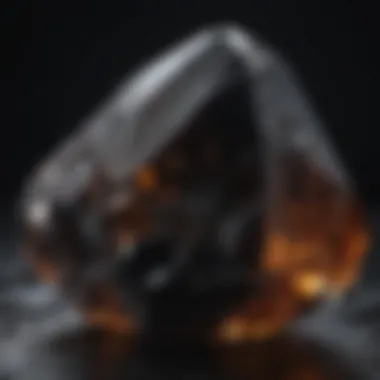
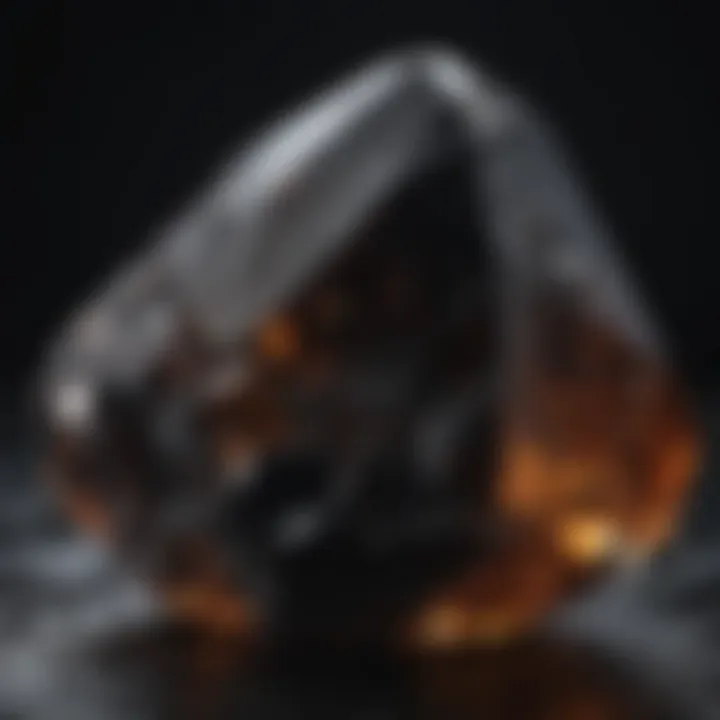
Conditions Favorable for Orange and Black Crystals
The specific environmental conditions favoring the growth of orange and black crystals are also essential. These crystals often form in regions with high volcanic activity, where minerals are squeezed and heated profoundly. Areas with abundant iron can lead to the development of black crystals. The presence of iron often dyes crystals black, as seen in minerals like magnetite and hematite.
In addition, acidic conditions can enhance the production of orange crystals. For example, in sedimentary environments, the presence of iron and specific conditions allow minerals like citrine to form. Moreover, the availability of trace elements and the proper temperature range can significantly affect crystal color and clarity. Simply put, the more conducive the environment, the more prominent and physically appealing the crystals will become.
Identification of Orange and Black Crystals
Understanding how to identify orange and black crystals is crucial for collectors and enthusiasts alike. The ability to accurately distinguish between different types of crystals not only helps in assuring authenticity but also enhances the overall appreciation for these mineral specimens. Misidentification can lead to misconceptions regarding their value, usage, and even their historical significance.
Physical Characteristics
When attempting to identify orange and black crystals, several physical characteristics should be carefully examined. Color and transparency are primary factors; orange crystals may show vibrant hues, while black crystals can range from opaque to somewhat translucent. Texture also plays an important role; for instance, the surface can be smooth or rough, which can indicate the type of mineral present.
Other significant attributes include the crystal system, which refers to the geometric arrangement of atoms within the crystal structure. Notable crystal systems for orange and black crystals are hexagonal and cubic. Additionally, observations regarding luster, which can be described as glassy, dull, or metallic, provide further insight into identification. The mineral hardness, measured using the Mohs scale, is another tangible characteristic that helps differentiate crystal types.
Chemical Composition
Chemical composition serves as the foundation for accurately identifying orange and black crystals. Each mineral has a unique combination of elements that can significantly affect its color, crystal structure, and even hardness. For example, orange crystals like citrine contain silicon dioxide, while black crystals such as obsidian are composed of natural glass formed from volcanic lava.
To establish a correct identification, understanding the chemical formula is vital. This information can typically be sourced from mineralogy databases or scientific literature. Furthermore, some orange and black crystals may share similar physical elements but differ in trace minerals, impacting their appearance and properties. For collectors, knowing these distinctions supports both authenticity verification and appreciation of the mineral's unique traits.
Testing Techniques for Accurate Identification
Accurate identification demands various testing techniques, which range from the basic to more advanced methods. Initially, simple tests can be performed directly at home, such as performing a scratch test to assess hardness. Crystals that are easily scratched may indicate lower hardness levels compared to those that resist the test.
More advanced techniques include:
- Refractive Index Measurement: A high-precision method utilizing light to calculate the refractive index of a crystal, aiding in identifying its mineral category.
- Spectroscopy: This analytical method involves studying the interaction of light with the crystals, revealing information about their molecular structure and composition.
- X-ray Diffraction: This high-end technique involves bombarding the crystal structure with X-rays, uncovering its unique atomic arrangement.
Each of these methods has its advantages and potential limitations, but collectively they contribute to a comprehensive understanding of orange and black crystals.
Remember: Accurate identification not only enhances your collection but also enriches your knowledge about these fascinating natural specimens.
Uses of Orange and Black Crystals
The significance of orange and black crystals extends beyond their mere existence in nature. These crystals hold considerable relevance in various fields, influencing industrial applications, healing practices, and artistic endeavors. Understanding their uses not only enhances our appreciation for these natural wonders but also provides insights into the broader implications for technology, health, and culture.
Industrial Applications
Orange and black crystals are essential in various industrial sectors. For example, Garnet, often found in hues of orange, is frequently used as an abrasive material in sandblasting and waterjet cutting. The durability and hardness of this mineral make it ideal for precision cutting tasks demanding high resistance to wear.
Moreover, black crystals such as Hematite play an important role in the iron and steel industry. Hematite serves as a primary ore of iron, which is crucial for steel production, which is necessary for construction and manufacturing. This mineral's magnetic properties have also led to applications in electronics.
- Mining: Extraction of valuable ores.
- Manufacturing: Utilized in production processes.
- Technology: Elements like electron microscopy utilize various minerals.
These industrial uses highlight the importance of orange and black crystals in driving modern advancements. Their unique properties allow them to contribute effectively in multiple scenarios, profoundly impacting everyday life.
Healing and Metaphysical Properties
Beyond industrial applications, orange and black crystals are often associated with spiritual and healing properties. Many believe that these crystals can promote emotional and physical well-being. For instance, Carnelian, an orange variety, is considered to inspire courage and motivation. Practitioners of crystal healing often recommend Carnelian for enhancing creativity and reducing negative emotions.
In contrast, black crystals like Obsidian are regarded as protective stones. They are thought to absorb negative energy and provide a grounding force. This grounding element is vital for individuals seeking clarity and stability in their lives.
- Energy Enhancement: Believed to improve emotional health.
- Stress Relief: Many users find comfort in holding or wearing these stones.
- Spiritual Awareness: Helps in enhancing meditation practices.
The metaphysical associations of these crystals have carved a niche for them in alternative medicine and spiritual practices. Their use in healing and as tools for personal transformation makes them appealing to a broad audience.
Art and Aesthetic Value
The aesthetic appeal of orange and black crystals contributes to their growing presence in the art world. Artists and designers often utilize these crystals in jewelry, home decor, and other creative expressions. For example, the striking appearance of Black Tourmaline and its versatile colors provides a dramatic element in handcrafted pieces.
In addition to being visually striking, these crystals carry symbolic meanings. Orange crystals may symbolize optimism and vitality, while black ones often represent strength and protection. This duality enhances their desirability among collectors and buyers.
- Jewelry: Crafted into beautiful accessories.
- Interior Design: Used in decorative pieces to enhance ambiance.
- Collectibles: The unique characteristics make them perfect for collections.
The fusion of aesthetic beauty with inherent meanings adds depth to the value of orange and black crystals. This combination attracts not only collectors but also artisans who resonate with the rich history of these unique formations.
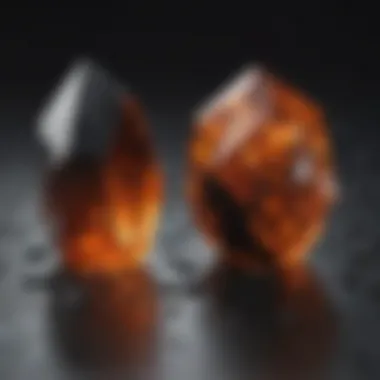
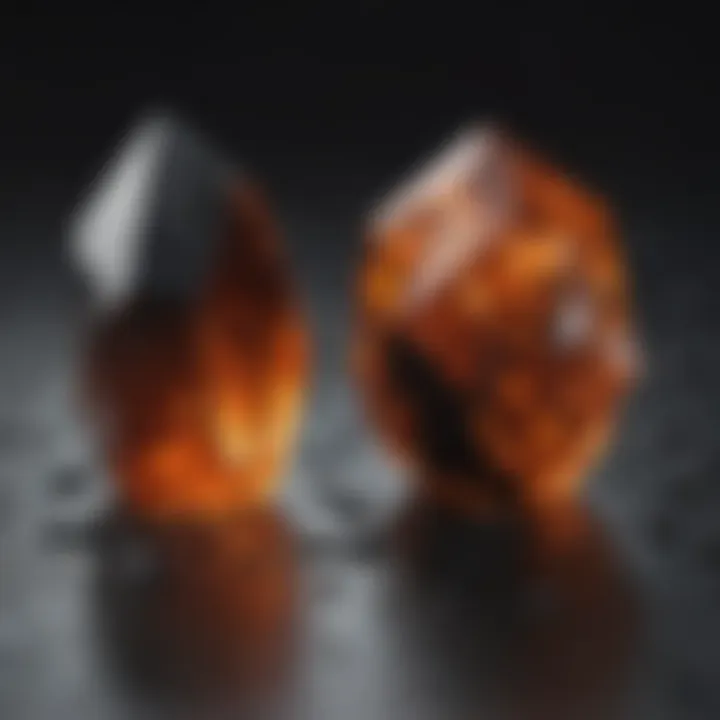
The diverse uses of orange and black crystals illustrate their integral role in various domains, showcasing how they shape both practical and cultural landscapes.
Cultural and Historical Significance
The cultural and historical significance of orange and black crystals extends far beyond their aesthetic appeal. These minerals hold a unique place in human history, often intertwined with various beliefs, practices, and traditions across regions and eras. Understanding their historical context allows us to appreciate their roles fully, from ancient civilizations to contemporary society.
Ancient Beliefs and Practices
Many ancient cultures attributed profound meanings to crystals, particularly those that exhibit vibrant colors like orange and black. For instance, in ancient Egypt, carnelian, an orange crystal, was believed to possess protective qualities. It was often used in jewelry and burial items to safeguard the deceased in the afterlife. Similarly, ancient Chinese traditions recognized the value of black tourmaline for its purported ability to absorb negative energies, making it a popular stone for both spiritual and physical protection.
In Indigenous cultures, these crystals often served as tools for rituals and healing. Orange crystals, with their warm hue, were seen as symbols of life and energy. They were used in ceremonies to celebrate change and transformation. On the other hand, black crystals frequently represented stability and grounding, believed to facilitate a connection between the earth and the spiritual realm.
- Protective Uses:
- Symbolic Uses:
- Carnelian in ancient Egypt
- Black tourmaline in Chinese traditions
- Orange crystals for life and energy
- Black crystals as grounding tools
These practices highlight the profound relationship between humans and these crystals, illustrating their significance beyond mere decoration.
Modern Perspectives
Today, the relevance of orange and black crystals continues to evolve. Modern collectors and enthusiasts often integrate ancient beliefs with contemporary practices. Crystals are now seen not just as geological specimens but as tools for self-awareness and healing.
In the realm of wellness, orange crystals are frequently associated with creativity and joy. People use them in meditation to invoke positive energy and emotional balance. Meanwhile, black crystals are valued for their grounding energy, helping individuals navigate daily stresses by providing a sense of security and stability.
In addition to personal uses, these crystals find their way into New Age practices, holistic healing sessions, and interior design, where their colors and characteristics enhance environments and promote well-being. As society progresses, these minerals gain new interpretations and applications.
"Crystals serve as a bridge connecting our past beliefs with modern-day understandings of self and nature."
- Integration into Wellness:
- Role in Modern Practices:
- Orange crystals for creativity
- Black crystals for grounding
- Used in meditation
- Aesthetic value in interior design
The historical significance of these crystals shines through their present applications, underscoring a continuity of interest and reverence that spans generations.
Caring for Your Crystal Collection
Caring for a crystal collection is essential for collectors who wish to maintain the quality and beauty of their specimens. Proper care enhances the longevity and durability of crystals, ensuring that their unique characteristics are preserved over time. Each type of crystal may have different needs for storage, cleaning, and preservation. Failing to follow suitable practices may result in damage that diminishes their aesthetic appeal and, potentially, their value.
Proper Storage Techniques
Storing crystals is a fundamental aspect of care. The environment can impact the integrity of the stones. Here are a few important points to consider:
- Temperature and Humidity: Crystals should be kept in a stable environment, away from extreme heat or humidity. Fluctuations can create stress within crystals and lead to fractures or changes in color.
- Separate Storage: It is wise to store crystals separately, especially those with harder surfaces next to softer ones. This reduces the risk of scratches and chips. Using soft pouches or dividers can help in keeping each crystal protected.
- Display Considerations: When displaying crystals, use sturdy racks or cases that offer protection from dust and accidental falls. Avoid direct sunlight, which can fade bright colors over time.
Cleaning Methods
Cleaning crystals is necessary to keep them looking their best. However, the cleaning method will vary based on the type of crystal. General suggestions include:
- Gentle Washing: Use mild soap and warm water for cleaning. Avoid harsh chemicals that can compromise the crystal's surface.
- Soft Brushes: For detailed cleaning, a soft-bristled brush can be employed to remove dust and grime that may accumulate in crevices.
- Natural Touch: For some crystals, a simple rinsing under lukewarm water may suffice. However, ensure that the crystal is water-safe first to avoid damage.
"Cleaning and proper care can significantly extend the life and vibrancy of your crystal collection."
Preservation Considerations
To preserve crystals effectively, collectors should consider the following:
- Regular Inspections: Routinely check crystals for any signs of damage or deterioration. Early detection allows for corrective actions before minor issues escalate.
- Protective Coatings: Some collectors may choose to apply a protective layer to enhance durability, especially for softer crystals.
- Educate Yourself: Understand each crystal's unique properties. Some may require special considerations regarding cleaning or storage.
Valuation of Orange and Black Crystals
Valuation of orange and black crystals is a vital aspect when collectors, enthusiasts, and investors seek to engage with these natural specimens. Understanding the market value allows collectors to make informed decisions regarding purchases, sales, and trade. This section highlights essential elements affecting the valuation, including aesthetic qualities, rarity, and demand. Each of these factors plays a critical role in establishing the market worth of these unique crystals.
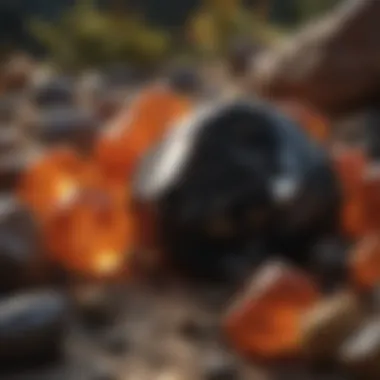
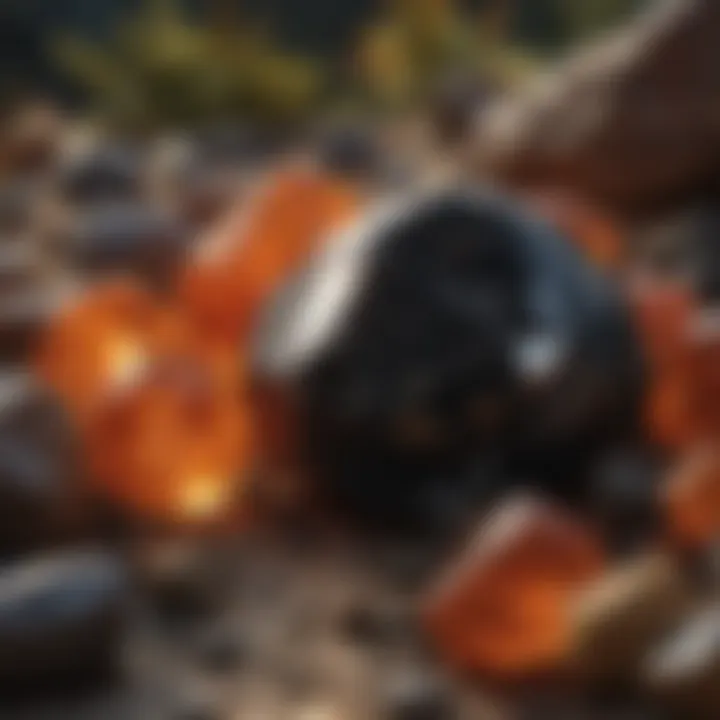
Factors Affecting Market Value
The market value of orange and black crystals can fluctuate due to several interrelated factors. The following points outline the most significant considerations:
- Rarity: Crystals that are harder to find can command higher prices. For instance, certain types of black tourmaline can be rarer than commonly found orange calcite.
- Quality: The aesthetic appeal influences value substantially. Crystals with vivid colors, clarity, and unique formations tend to have greater demand and thus higher prices.
- Size: Larger and well-formed specimens often carry more substantial price tags. Size must be evaluated in context with quality; a small, perfect specimen may be more valuable than a larger, flawed one.
- Provenance: The history of a crystal’s discovery and ownership can add to its value. Collections that are well-documented with reputable origins tend to be more sought after.
- Market Demand: Trends in collecting can shift rapidly. For instance, during a period when the interest in metaphysical properties is high, related crystals may see increased valuations.
Resources for Valuation
To accurately assess the value of orange and black crystals, collectors can reference a variety of sources. These resources provide crucial information, pricing trends, and community insights:
- Gem and Mineral Shows: Attending these events allows collectors to speak directly with sellers and experts. Prices at these shows can reflect the current market accurately.
- Online Marketplaces: Websites like eBay or Etsy offer insights into what similar crystals are being sold for. This can help in establishing a rough market value.
- Books and Guides: Publications such as "The Book of Crystals" can provide detailed information on specific types of crystals and their valuation.
- Online Forums: Participate in communities on Reddit or Facebook where collectors share their experiences and recent sales. This input is often invaluable.
- Appraisers: Consulting with certified gemologists can provide an objective and professional assessment of a crystal’s value.
"Knowing how to accurately value your collection not only helps in trading but also preserves the joy of collecting while avoiding financial pitfalls."
In summary, understanding the valuation of orange and black crystals encompasses several factors and resources that collectors must navigate. The interplay between rarity, quality, size, provenance, and market demand will continue to shape how these crystals are perceived and valued in the natural history landscape.
Ethical Considerations in Crystal Collecting
Understanding the ethical implications of crystal collecting is vital for participants in the field, as it reflects both personal values and a collective responsibility toward the environment. Collectors, especially those focused on orange and black crystals, must navigate a landscape that often intersects with issues such as sustainability, legality, and the cultural significance of mineral specimens. By being informed about these considerations, collectors can positively contribute to the preservation of natural resources while also enriching their own collecting experience.
Sustainable Sourcing Practices
Sustainable sourcing practices ensure that the collection of crystals does not harm ecosystems or deplete natural resources. It is essential to recognize that many crystals, including those of striking orange and black hues, are extracted from environments that can be fragile or threatened. When sourcing crystals, consider the following practices:
- Choose ethical vendors: Support suppliers who prioritize responsible mining practices and can trace the origins of their products.
- Work with local miners: Engaging with local mining communities can promote fair labor practices and help maintain traditions in mineral extraction.
- Invest in synthetic crystals: Although natural specimens have undeniable charm, synthetic alternatives can often provide similar aesthetic qualities without environmental impacts.
By prioritizing sustainable sources, collectors can protect local ecosystems and minimize harm to biodiversity.
Legislation and Regulations Surrounding Collecting
Legal frameworks governing crystal collection vary by country and region, making it crucial for collectors to stay informed about existing regulations. Many places have strict laws about the collection of minerals, especially those that are scarce or threatened. Some key points to consider include:
- Local laws: Familiarize yourself with the laws in your area regarding the collection of minerals. This may include necessary permits, restricted zones, or protected areas.
- Cultural heritage: Be aware of cultural laws that safeguard certain mineral specimens that hold historical significance. Collecting these without permission can result in legal repercussions and ethical dilemmas.
- Environmental protections: Many regions have established conservation measures that prohibit the extraction of certain minerals to protect ecosystems. Ensure compliance to contribute to conservation efforts.
Collectors who respect legal and cultural guidelines demonstrate a commitment to responsible practices, enhancing the integrity of the hobby.
Community and Sharing Knowledge
Understanding orange and black crystals goes beyond individual study. It fosters a sense of belonging. This community can support, inform, and inspire collectors. Engaging with others enhances knowledge and appreciation for these unique minerals.
Connecting with Fellow Collectors
Connecting with fellow collectors offers notable advantages. Engagement can lead to meaningful exchanges of ideas. Individuals often share personal stories and experiences that resonate deeply. For example, discussions in informal groups may reveal unique identification methods. These methods enhance one's understanding of crystal characteristics. This connection often extends to localized gatherings, including trade shows or community events.
Moreover, forming relationships within this community can lead to collaborative research. Collectors often help pinpoint geological sites. These sites might yield orange and black crystals. Sharing personal finds increases the collective understanding of these minerals.
This sense of community is not just about sharing finds. It's also about sharing knowledge and skills that develop over time. Collectors can learn about effective preservation methods, suitable storage solutions, and appropriate cleaning techniques. Having a support network is vital in cultivating passion for these crystals.
Online Resources and Forums
In the digital age, online resources play a crucial role in crystal collecting. Forums like those on Reddit and Facebook provide platforms for discussion and discovery. Members can ask for advice, post queries, and seek insights from experienced collectors.
These online resources offer a wealth of information. Users often share research on market trends and valuation of orange and black crystals. Additionally, tutorials abound, teaching members about identification techniques or cleaning methods. This accessibility to information empowers collectors at any knowledge level.
Guided discussions and shared resources lead to a greater appreciation of orange and black crystals.
"The beauty of crystal collecting is the community. Sharing knowledge is as important as the crystals themselves."
In summary, connecting with fellow collectors and utilizing online resources offers great benefits. They enhance knowledge and appreciation for orange and black crystals. Engaging in this collective effort enriches the experience for all involved.
Culmination
The significance of orange and black crystals in natural history encompasses multiple dimensions, from their geological formation to their cultural implications. These crystals are not mere decorative items; they reflect intricate processes that have shaped our planet and offer insights into its history. The need for understanding their properties can enhance the appreciation for these natural wonders.
Summarizing Key Points
Throughout this article, several key points emerge. First, the geological formation processes of orange and black crystals reveal how environmental conditions influence their characteristics. From physical traits to chemical compositions, identification techniques help collectors and enthusiasts discern between different types of crystals. Also, various applications of these crystals underscore their importance in industry, healing practices, and artistic endeavors. Understanding their historical significance enriches our perception of these items beyond their aesthetic value. For aspiring and seasoned collectors, this foundational knowledge is crucial. It improves their skillset in identifying, collecting, and caring for crystals.
Future Trends in Crystal Collecting
As the field of crystal collecting evolves, several trends begin to take shape. One particular trend is the growing emphasis on ethical sourcing. Collectors are more discerning about where crystals are obtained, favoring places that prioritize sustainability. This shift influences market valuations and encourages responsible practices within the community. Furthermore, advancements in technology contribute to better identification tools. Tools like spectrometers and digital databases make it easier to verify authenticity and provenance. The rise of online forums and social media platforms allows for the exchange of knowledge. Collectors share their experiences and tips, creating a richer collective understanding.
In summary, the exploration of orange and black crystals illustrates their importance in both natural and cultural contexts. Embracing these trends prepares collectors for a future where ethical considerations and technological innovations will shape the world of crystal collecting.



